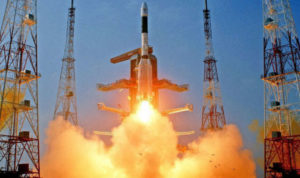Indian Space Program
Indian Space Program: INCOSPAR:
The Indian space program has its genesis in 1962 when the National Committee for Space Research (INCOSPAR) was established with Vikram Sarabhai playing a pivotal role.
Indian Space Program: Thumba Equatorial Rocket Launching Station (TERLS)
Thumba is a suburb of Thiruvananthapuram in the Indian state of Kerala from where the magnetic equator passes. The magnetic equator is an imaginary line around the planet that connects all the points where a magnetic needle, when freely suspended, is horizontal. It is scientifically important because the magnetic equator is where the Equatorial Electrojet exists. The equatorial electrojet (EEJ) is a narrow ribbon of current flowing eastward in the Earth’s ionosphere. Sounding rockets, or the first rockets sent out by any space programme, test and study these electrons for research in the fields of physics, astronomy, and meteorology. Thumba became prominent after the establishment of Thumba Equatorial Rocket Launching Station (TERLS), which was the first of that kind in India. The the first rocket launch from India took place in November 1963 from TERLS with the launch of a two-stage Nike Apache sounding rocket
Indian Space Program: ISRO: INCOSPAR became the Indian Space Research Organisation (ISRO) in 1969.
Indian Space Program: The Vikram Sarabhai Space Centre (VSSC)
TERLS was renamed as the the Vikram Sarabhai Space Centre post the sudden demise of Vikram Sarabhai in 1971. It has gradually developed into one of the main research and development establishments within ISRO. VSSC has been instrumental in the development of sounding rockets, the Rohini and Menaka launchers, and the ASLV, PSLV, GSLV and GSLV Mk III families of launch vehicles.
Indian Space Program: Satish Dhawan Space Centre (SDSC): Sriharikota
Formerly known as the Sriharikota High Altitude Range (SHAR) this centre was renamed in 2002. Sriharikota is a barrier island off the Bay of Bengal coast located in the Indian state of Andhra Pradesh. It was chosen in 1969 for a satellite launching station. it is India’s primary orbital launch site to this day. The Centre has two operational orbital launch pads.

Indian Space Program: Aryabhatta
ISRO built India’s first satellite, Aryabhata, which was launched by the Soviet Union in 1975
Indian Space Program: Rohini
Rohini was the first satellite to be placed in orbit by an Indian-made launch vehicle, SLV-3 in 1980.
Indian Space Program: SLV
The Satellite Launch Vehicle, usually known by its abbreviation SLV or SLV-3 was a 4-stage solid-propellant light launcher. It was intended to reach a height of 500 km and carry a payload of 40 kg
Indian Space Program: ASLV
The Augmented Satellite Launch Vehicle, usually known by its abbreviation ASLV was a 5-stage solid propellant rocket with the capability of placing a 150 kg satellite into Low Earth Orbit. This project was started by the ISRO during the early 1980s to develop technologies needed for a payload to be placed into a geostationary orbit. It was later decommissioned
Indian Space Program: PSLV
The Polar Satellite Launch Vehicle, commonly known by its abbreviation PSLV, is an expendable launch system developed by ISRO to allow India to launch its Indian Remote Sensing (IRS) satellites into Sun synchronous orbits. PSLV can also launch small satellites into geostationary transfer orbit (GTO).
Indian Space Program: GSLV
The Geosynchronous Satellite Launch Vehicle, usually known by its abbreviation GSLV, is an expendable launch system developed to enable India to launch its INSAT-type satellites into geostationary orbit and to make India less dependent on foreign rockets. At present, it is ISRO’s second-heaviest satellite launch vehicle and is capable of putting a total payload of up to 5 tons to Low Earth Orbit. The vehicle is built by India with the cryogenic engine purchased from Russia while the ISRO develops its own engine programme.
On 5 January 2014, GSLV-D5 successfully launched GSAT-14 into intended orbit. This also marked first successful flight using indigenous cryogenic engine, making India the sixth country in the world to have this technology.
Indian Space Program: Astrosat
Astrosat is India’s first dedicated multi-wavelength space observatory on an IRS class satellite. It was launched in 2015. Its focus is multi-wavelength monitoring of intensity variations in a broad range of cosmic sources covering spectral bands from radio, optical, IR, UV, and X-ray wavelengths.
Indian Space Program: Indian Remote Sensing Program
India began to develop the indigenous Indian Remote Sensing (IRS) satellite program to support the national economy in the areas of agriculture, water resources, forestry and ecology, geology, water sheds, marine fisheries and coastal management. India established the National Natural Resources Management System (NNRMS). The IRS system is one of the biggest systems of remote sensing satellites for civilian use in the world
Indian Space Program: CARTOSAT
Cartosat series of satellites are a type of earth observation satellites indigenously built by India. Up till now 6 Cartosat satellites have been launched by ISRO. The Cartosat series is a part of the Indian Remote Sensing Programme. They were specifically launched for Earth’s resource management and monitoring. Each of these satellites carries two state-of-the-art panchromatic (PAN) cameras that take black and white stereoscopic pictures of the earth in the visible region of the electromagnetic spectrum.

The package consists of summaries of curated sources for studying the most critical subjects of UPSC in the most comprehensive manner. The summaries are prepared in consultation with exam toppers and serving/retired civil servants along with our own team of experts who ensure that you refer to the most relevant content in your preparation journey.
In the current exam scenario the bigger challenge is not the lack of material but the availability of excessive material that often confuses aspirants. Hence this package is our endeavor to minimize wastage and maximize utilization of an aspirants precious time. What will also be of interest to you is the fact that unlike many other institutions we have prepared the whole package in an editable format so that you can easily edit, append, delete the notes to suit your current preparation.
Quality of the notes is our most important focus. Coming from the house of PSCPREP you can be rest assured that the notes are of the topmost quality.